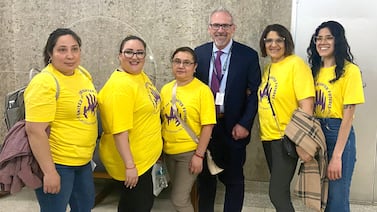In Susan Tran’s first grade class in the Boulder Valley School District this past school year, she and a fellow teacher worked as a team — helping students focus on the language of math, breaking apart word problems and using words to compare, contrast, and describe different shapes.
The two-teacher arrangement is part of changes the Boulder school district is rolling out in how students identified as English learners receive language services in elementary schools.
Instead of pulling students from their classroom for approximately 45 minutes a day to receive English language development, the district is moving to a co-teaching model, where a teacher specialist pops into regular classrooms to help lead a lesson for all students with the classroom teacher.
“Anytime you watch a new teacher, you learn something new,” said Tran. About half of the students in her class are English learners.
“I observed students speaking with more robust academic vocabulary and in more complete sentences,” said Rachelle Weigold, one of the English language development teachers who worked with Tran. “I think those were really fantastic advancements.”
It’s a change some Latino parents had requested years ago and which the district has tried out — unsuccessfully — before.
At Alicia Sanchez Elementary in Lafayette where Tran and Weigold work, nearly 36% of students — up to half in some classes — are identified as English learners, students who primarily speak a language other than English. Because of that, the school had already been trying co-teaching for some time. But this year there was a new focus on intentional planning before the co-taught lessons. Co-teaching during math class was also new.
Come fall, eight more schools will join the four that started the model this year. Most Boulder elementary schools are scheduled to make the switch in the next few years. Each school decides which subject to pair with the English language development, but many are focusing on math.
Under federal civil rights laws, school districts have to provide students identified as English learners with services to help them learn the language so they can access their education.
In Boulder, where about 7% of the district’s students are identified as English learners, those language services had primarily been provided through a pull-out model in which specialist teachers give students targeted instruction in learning English and being able to access the rest of their learning.
It’s rare for school districts to change how they offer services.
But Boulder Valley School District has long had some of the largest gaps in how students who are English learners score on state tests, compared to students who are native English speakers.
The most recent state test results showed a 54.7-percentage point gap, one of the widest in the state. In 2022, 9.1% of Boulder students identified as English learners scored proficient or above on state tests, compared to 7.9% of the same group who scored proficient or above statewide. But 63.8% of native English speakers in Boulder met or exceeded expectations.
District leaders have said improving outcomes for English learners and closing that gap is one of their long-term goals. In the short term, the goals are around improving teachers’ capacity to support students through the day and giving students better access to their education.
One of the most important goals “is not pulling students from their grade level peers and not having them feel different than,” said Kristin Nelson-Stein, director of culturally and linguistically diverse education in the Boulder Valley School District.
District leaders said they had tried co-teaching before but it hadn’t quite worked.
“It just didn’t stick really,” said Meghan McCracken, a culturally and linguistically diverse education coordinator in the Boulder Valley district. “We really didn’t have support at the highest levels for the program shift.”
Randy Barber, a spokesperson for the district, said improving systems for English language learner instruction has been a priority, but that listening to parents and getting everyone aligned on how things should change takes time.
This time, part of helping get everyone on the same page involved visiting the Cherry Creek School District to observe how they use co-teaching models for English language development.
Concerned parents were a driving force
Latino parents had asked for these changes years ago. Many felt the recommendations had been forgotten.
Ana Lilia Lujan was one of the parent leaders who made that recommendation. Her son, who just graduated from the district this year, struggled with English most of his time in school. When he was starting middle school and still not making progress in English language development, Lujan decided to opt him out of services.
“I was really scared of removing him from those classes, but I thought, no, it’s been too many years,” Lujan said. “I removed him and they put him in regular classes. That helped him a lot. His self-esteem changed. His English improved because he was listening to students that knew more.”
Lujan, who spent years trying to understand how students who are learning English are identified and served, said she has come to believe that the pull-out methods are ineffective.
“Taking kids out of class doesn’t work,” Lujan said. “Once you reach a certain point, the kids are never going to catch up to the others because of what they’re missing. And the kids think they’re not smart, because of how they’re being treated.”
She said she wants districts to acknowledge that students are smart, despite how they may struggle on state tests.
“Let’s not confuse not knowing a language with a lack of intellectual capacity,” Lujan said.
Lujan also worries that not enough parents have the time she did to learn about the complicated system or to learn that other models could work better. That means fewer are able to advocate for changes, putting less pressure on districts to be creative in looking for solutions to improve learning, she said.
Researchers who study English language development say the pull-out model has benefits, but is not generally the most effective. But moving to co-teaching is not automatically better, they say.
“Pull-out ESL sometimes makes kids feel stigmatized or not maybe as smart as the other kids in their regular classroom,” said Kathy Escamilla, a researcher and former leader of the BUENO Center for Multicultural Education at CU Boulder. “Now on the other hand, co-teaching might work fine in math. It might help the kids, but that depends on what strategies they’re using.”
Ester J. de Jong, professor of culturally and linguistically diverse education at the University of Colorado-Denver, said pull-out models can provide safe learning environments and work best when they help students build on what they learn in their regular classrooms the rest of the day.
Once students reach a certain point in language development, there’s no reason to pull them out of an English-language classroom just to get more English instruction, de Jong said. “But that doesn’t mean students don’t have needs that don’t have to be met.”
Isolated pull-out groups can be especially helpful for new immigrant students who might have more distinctive needs, she said.
District leaders said newcomer students may still be pulled out for support for their first couple of months in the school district, until they’re ready to receive help in the classroom.
Both models require teachers to have a lot of preparation and time to coordinate, researchers said.
Teachers at Sanchez said the shift to co-teaching has been hard work, but their structure has allowed for a lot of good planning, coordination, and learning from each other.
The planning helps them adjust lessons for students with varying abilities, the teachers said, but they never segregate students in the classroom simply based on the identification of being English learners.
Elizabeth Dawson, another teacher at Sanchez, said students might have different language needs based on past traumas, poverty levels, or other external factors.
“There’s very many reasons students might need language support,” Dawson said.
Lujan, the Boulder parent, is optimistic, but said she’ll still be watching to see if it contributes to better outcomes for Latino students in the district.
“That will be the question,” Lujan said. “The fact that they’re doing this is already a good step. But we still have to see the results. That’s always been my point.”
Yesenia Robles is a reporter for Chalkbeat Colorado covering K-12 school districts and multilingual education. Contact Yesenia at yrobles@chalkbeat.org.








